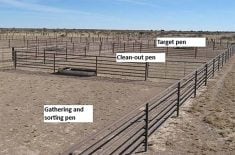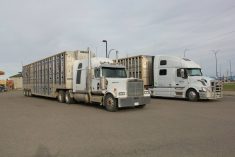Few things can damage your bond with your dog like coming home to a mess — torn curtains, feces or urine on the floor and a scratched door jamb.
Your dog’s guilty look is probably a read of your own stress. Dogs that wreak havoc like this are likely suffering from separation anxiety, a very common disorder.
Dogs with this condition become extremely anxious when left alone, leading to house soiling, excessive drooling, destructive behaviour and sometimes barking or whining. They may attempt to escape through doors and windows.
Read Also

Charges laid after cattle theft
Saskatchewan RCMP lay two charges against a man after six cattle went missing.
While the destruction itself can cause injury to the dog, these extreme behaviours also have a severe, negative impact on the dog’s quality of life.
Diagnosis of separation anxiety can involve some sleuthing, especially in multi-dog homes. Video cameras can document behaviours and show which dog is affected. It also establishes a baseline to evaluate if therapy is beneficial.
A diagnosis of separation anxiety is reached through a thorough history and by ruling out other causes. For instance, a dog that house soils when people are around has a house training issue and is not necessarily affected by separation anxiety.
A consultation with a veterinarian is recommended. Providing videos and details of your dog’s behaviours when you are away will be helpful. In severe cases, your vet may suggest a referral to a veterinary behaviourist.
Separation anxiety can be challenging to treat and requires a multi-pronged approach. Avoid leaving the dog alone if possible until behaviour modification can be done.
The latter starts by reducing stress around departure and return. Avoid interactions and reassurances when you leave and ignore your dog when you return until he is calm. Even if your dog does not have separation anxiety, this is a good preventive practice.
If you do come home to a mess, avoid punishment because this will only increase the dog’s overall anxiety. Additionally, they will learn to fear your return rather than learn not to make a mess because it was probably done hours before your return.
Behaviour modification is accomplished by gradually desensitizing your leaving cues. This involves identifying which cues create anxiety.
Anxious behaviours such as footpad sweating, shaking, panting, drooling, pacing, lack of interest in food and following the person to whom they are attached can occur before the person leaves. Observe which of your cues start these behaviours, such as changing clothes, brushing teeth, picking up keys and putting on shoes and coats.
Do these things at random, without leaving, to decrease the association between them and your leaving. You may feel silly walking around your house in your jacket, but your dog won’t judge you.
Training dogs to be independent can also help. This involves leaving your dog for progressively longer periods, starting by a few steps away and increasing the distance and duration. Only return to your dog when he is calm.
Ensure the dog is getting adequate exercise and stimulation. Tired dogs that are given plenty to do will have less energy to be anxious. Toys that hold treats and dog food puzzles are a fantastic addition to create mental stimulation while you are away.
Unfortunately, crating dogs that are not accustomed to confinement will limit the damage to your home but will not resolve underlying anxiety problems.
There are two veterinary medications approved for use in dogs with anxiety disorders in Canada: Clomicalm and Reconcile. A combination of behaviour modification and medication usually has better success than either alone.
Both medications work to decrease overall anxiety, which can permit learning to occur. Dogs that are overly anxious cannot learn.
Another product worth trying is a commercially available synthetic version of the pheromone that lactating female dogs excrete to calm their puppies. Dubbed “dog appeasing pheromone”, this product is sold as a spray, collar or plug-in diffuser.
Building independence through desensitization and training will benefit any dog, whether or not it has separation anxiety. If your dog has been diagnosed with this behaviour problem, successful treatment is possible but it will take time and effort.

















